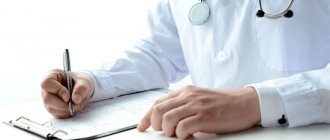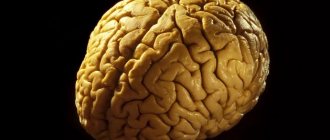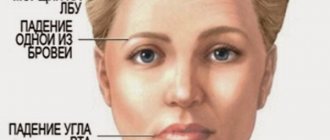The definition of acoustic-mnestic aphasia is actively used in neuropsychology to describe one of the forms of speech disorders. In this case, the disorder affects the process of perceiving each new word and comparing it with the previous one. As a result, a significant part of the information simply falls out of the victim’s memory, which is why he is unable to reproduce it. Inferiority of auditory-verbal memory requires careful diagnosis and professional help. With timely initiation of therapy and its comprehensive organization, the prognosis is favorable. Ignoring the problem leads to its rapid regression.
The disease affects the process of perceiving each new word and comparing it with the previous one.
Classification
In order to choose the right treatment tactics and form an adequate prognosis, it is very important to determine the type of aphasia. There are several classifications of this disease, however, when conducting diagnostics, the following division of aphasia is considered the most significant:
- Sensory or Wernicke's aphasia . This form of the disease affects the upper part of the temporal lobe of the brain. In this case, a disorder of phonetic hearing occurs, in which a person confuses sounds. As a result, he hears words, but they remain incomprehensible to him. If the disease is severe, impressive and expressive speech suffers. It is also common for a person to lose the ability to read words out loud or write a sentence.
- Acoustic-mnestic aphasia . In this case, the middle third of the temporal gyrus suffers, which leads to problems with auditory-verbal memory. A person understands the speech of others, but quickly forgets the information received. Reading abilities are preserved, patients can copy the provided data. At the same time, oral speech has a poor vocabulary; a person can skip essential words or change them to other definitions.
- Afferent motor aphasia . This disease occurs when the lower part of the postcentral cortex is damaged. A person loses the ability to control articulatory movements. If serious problems arise, the patient is able to make only certain sounds. Often a person can speak only some of the words that he often said before the development of the disease. Physician examination shows changes in tongue control. So, the patient cannot touch his lips with it or loses the ability to puff out his cheeks.
- Efferent motor aphasia . It develops when Broca's area, which is located in the lower region of the premotor region, is damaged. In this case, a person tries to switch from one form to another. With a mild degree of the disease, the patient tries to select words with similar syllables or uses common expressions to construct his speech. During a conversation, a person constantly pauses and misses verbs. In difficult cases, it can only make individual sounds. If the disorder persists for a long time, problems with reading and writing occur.
- Optical-mnestic aphasia . Appears when there is a violation of the temporo-occipital region, located in the left hemisphere of the brain. In this case, a person loses the connection between the word and its meaning. Therefore, patients are forced to spend a long time choosing the names of phenomena or objects, which negatively affects the speed of their speech.
- Dynamic aphasia . This type of disease is characterized by disruption of the premotor areas that are adjacent to Broca's area. As a result, the integrity of the statement suffers, and it is difficult for him to construct his own speech. People with this disorder give monosyllabic answers to questions and often repeat the last words.
In foreign literature you can find a simpler classification of this disease:
- Posterior aphasia - this term refers to organic lesions of the posterior part of one of the hemispheres. Speech with this diagnosis remains quite understandable and retains its fluency.
- Non-fluent aphasia is characterized by a violation of the anterior lobe of a certain hemisphere. In this case, the pronunciation of words and sentences suffers.
Depending on the intensity of the manifestations of the disease, the following types are distinguished:
- total aphasia - in this case the patient’s speech is completely impaired;
- partial aphasia - only some elements of disorders are present when normal speech is replaced by pathological one.
Causes of aphasia
Aphasia can be caused by any disease or pathological process that provokes irritation of a certain lobe of the cerebral cortex or nerve pathways. These include the following deviations:
- Poor blood circulation in the brain - it can be acute or chronic.
- Tumor formations in the brain.
- Traumatic brain damage.
- Development of an abscess in the brain.
- Demyelinating pathologies, which are characterized by the breakdown of myelin - this protein ensures the transmission of impulses along nerve fibers. Similar disorders occur with multiple sclerosis or encephalomyelitis.
- Epilepsy is a pathology characterized by the appearance of an epileptogenic focus in the brain. From time to time, an electrical discharge suddenly occurs in it, which leads to disruption of brain function.
- Poisoning with toxic substances - these can be poisons and salts of heavy metals.
- Degenerative pathologies gradually provoke changes in the structure of the brain. These include Creutzfeldt-Jakob disease, which is of infectious origin and manifests itself in the form of developing dementia and a large number of neurological symptoms.
Risk factors for the development of aphasia usually include older age, the presence of heart defects, atherosclerosis and hypertension.
Symptoms and course of the disease
The main symptom of aphasia, which is characteristic of all forms of the disease, is speech impairment. In this case, the features of the pathology directly depend on the area of brain damage:
- Sensory aphasia is characterized by damage to the temporal region of the brain, with the left side usually affected. The pathways that connect this area to other parts of the brain may also be disrupted. This type of aphasia manifests itself in the fact that a person does not understand the meaning of spoken words.
Therefore, the patient’s speech loses coherence, his words become inconsistent with each other. Another symptom of this type of aphasia is verbosity - a person tries in vain to convey his thoughts to others.
Despite the fact that the patient remains fully conscious and can concentrate, productive conversation is difficult due to speech disorders. Often such people are indignant that those around them do not understand them. This is due to the fact that they do not feel their defect.
- Motor or Broca's aphasia - it is characterized by a violation of the frontal lobe or pathways. As a result, a person has problems forming speech. The patient understands what he wants to say, but has difficulty starting a conversation or loses the ability to connect words normally.
This type of aphasia is characterized by abrupt and meager speech, and people often become silent. When starting a conversation, patients are unable to utter clear words, but they understand their problem, and therefore try to remain silent.
This means that with motor aphasia, a person perceives oral speech, but loses the ability to construct a normal conversation.
- Semantic aphasia is the result of a dysfunction in the parietal region of the brain or pathways. In this case, a person has difficulty establishing connections between complex concepts. This means that a person can carry on a conversation, but cannot determine who, for example, he is related to his father's brother.
- Amnestic aphasia - in this case, the work of the inner part of the temporal region of the cerebral cortex is disrupted. With such damage, the patient experiences difficulty naming objects. He can carry on a conversation quite normally, but is unable to name the object he sees. Such patients can identify an object only if the interlocutor names the first syllable.
Clinical manifestations
The inability to name an object is the main symptom of pathology, however, it is very difficult to identify this during normal communication. But the disease is manifested not only by aphasia. Symptoms include the following:
- Frequent repetition of the same words or phrases.
- Slowness of speech with pronounced pauses between words or, conversely, patients begin to speak very quickly and illogically.
- Speech becomes descriptive, that is, the patient skips nouns and speaks only with adjectives or verbs.
- A person easily describes an object and talks about its functions, but cannot remember the name of the object.
- When the patient is prompted with the first letter or syllable of the name of an object, he easily remembers the entire word.
- Mental disorders develop against the background of damage to other areas of the brain and can be characterized by frequent mood swings, aggression, isolation, foolishness, depression, apathy, paresis or paralysis, forgetfulness, etc.
Diagnostics
To make a correct diagnosis, the doctor must pay special attention to collecting and analyzing the medical history, because this type of disorder is associated with cerebrovascular pathologies. With a prolonged course of the disease, which entails personality changes, in old age a person may develop Alzheimer's or Pick's disease.
If necessary, the doctor collects a family history and interviews close relatives in detail. Of no small importance is a mental assessment of the patient’s condition and a neurological examination.
A specialist may be interested in how long ago speech problems appeared and what event preceded their occurrence. This could be a traumatic brain injury, a seizure, or a circulatory disorder in the brain. To make an accurate diagnosis, consultation with many specialized specialists is required - neurologists, speech therapists, psychologists.
Thus, a neurologist identifies speech disorders and other signs - changes in the height of reflexes, drooping of the corner of the mouth, weakness of the limbs, and facial asymmetry. The speech therapist must identify existing speech disorders and plan measures to restore it.
The following tests can also be used to diagnose aphasia:
- Electroencephalography - using this method, it is possible to evaluate the electrical activity of certain lobes of the brain. This indicator may deviate from the norm in a variety of pathologies.
- Computed tomography and magnetic resonance imaging - they allow you to analyze the structure of the brain layer by layer and determine the violation of the structure of its tissue. In addition, thanks to these procedures, it is possible to identify tumor formations, ulcers, hemorrhages, and areas of damage to nervous tissue.
- Magnetic resonance angiography - with this study you can determine the integrity and patency of cerebral vessels. It also allows you to identify aneurysms, vasoconstrictions and vascular malformations, which are a kind of tangle consisting of veins and arteries.
Establishing diagnosis
Since the pathology is associated with brain damage, the patient is recommended to make an appointment with a neurologist or psychiatrist. Specialists in this profile will be able to conduct the necessary research and select treatment.
During the initial consultation with a specialist, the doctor conducts a comprehensive diagnosis. It includes the following actions:
- Collection of complaints and medical history. It is necessary to know the time of onset of symptoms, against what background they developed and what chronic diseases the patient has.
- Assessment of neurological status. Gait, balance, cognitive skills are examined, the emotional-volitional sphere is assessed, an object recognition test is carried out, tests are carried out to assess the functional activity of the speech apparatus and individual components of speech - vocabulary, phonetics and grammar.
- Laboratory tests (clinical and biochemical blood tests, general urine examination, according to cerebrospinal fluid indications).
- X-ray of the skull.
- Ultrasound examination of neck vessels with Doppler.
- Computer, magnetic resonance or positron emission tomography of the brain to detect organic diseases of the central nervous system.
The list of procedures used for diagnosis depends on the symptoms a person has and concomitant diseases. Under no circumstances should you make a diagnosis yourself, as this often leads to progression of the underlying pathology.
Since the pathology is associated with brain damage, the patient is recommended to make an appointment with a neurologist or psychiatrist. Specialists in this profile will be able to conduct the necessary research and select treatment.
Treatment and correction
A patient with such a disorder requires constant attention from doctors and support from relatives. When choosing therapy tactics, one should take into account the fact that a person does not perceive speech, so recommendations must be brought to his attention in various ways. For this purpose, you can use gestures, drawings, or reproducing similar actions.
Therapy should include treatment of the underlying disease and sessions with a speech therapist. It is worth considering that it may take several years to restore speech. During this period, the patient needs the support of loved ones.
Of course, treatment of aphasia cannot be effective without eliminating the underlying disorder that led to its development. For this purpose the following activities can be carried out:
- Surgical removal of tumor formation.
- Removal of hemorrhage if it is localized superficially and can be eliminated through surgery.
- The use of anticonvulsants, which help prevent epilepsy attacks.
- Removal of an abscess from the cranial cavity, which is carried out surgically. After this procedure, it is imperative to prescribe antibacterial drugs to the patient.
- Normalization of pressure. A person may also be prescribed medications to improve blood circulation in the brain and normalize metabolism in case of such problems. The doctor may prescribe nootropic drugs and angioprotectors.
The tactics of training with a speech therapist are selected individually - it depends on the type of pathology. The first sessions should be devoted to motivating the patient to restore speech functions. The speech therapist needs to try to prevent the occurrence of stereotypical phrases in his speech.
Work with a person suffering from aphasia must necessarily be carried out in different directions. It is very important to work on written and spoken communication. Equally important is stimulating memorization and restoring reading ability.
Typically, patients with this disorder adequately perceive the surrounding reality, but the disease can provoke the development of depression or aggressiveness. The person may lose interest in continuing therapy. In such situations, you cannot do without the help of a psychologist. Successful recovery is impossible without the support of loved ones. People surrounding a sick person must adhere to certain rules:
- You should not talk with other people in the presence of the patient about his illness, problems and prognosis for recovery.
- It is very important to encourage a person to start a conversation on their own. You cannot pronounce complex words instead.
- A patient suffering from this disorder needs constant assistance in implementing medical recommendations. It is necessary to choose an accessible method of explaining the upcoming procedures and monitor the intake of medications.
- Such a person needs regular communication. To slow down the occurrence of other speech abnormalities, you should constantly talk to the patient, explain to him the events that are happening, and read aloud. With the help of TV or newspapers, he will not be able to restore impaired speech.
- It is important to show maximum patience, because often the patient has to explain incomprehensible terms several times.
Types of violation
To rehabilitate the nominative function in amnestic aphasia, stage-by-stage updating of the word through prompts and pictures is used. In the process of completing tasks, the patient again fills the memory with nouns, expands its volume, and trains brain activity.
Tasks for amnestic aphasia are developed individually, based on the symptoms of the disorder that appear in a particular patient. Their essence is as follows:
- The patient must be taught to identify the essential features of objects.
If we talk about an apple, the patient must remember where it grows, what its shape, color, size, and taste are.
- The next stage is to connect the mental image and memories of the object with the lexical shell of the word. This way, connections are restored between practical experience with a subject and its naming in expressive speech.
- The most difficult stage is explaining the polysemy of the word. It is possible to reach this level of rehabilitation if the patient’s vocabulary has been returned to normal volumes.
- After building up your vocabulary, you need to move on to training situational speech.
Comprehensive diagnostics allows you to make an unambiguous diagnosis. Based on the research results, the patient’s age and mental state, the attending physician selects a treatment regimen. Therapy is always complex.
After emergency treatment, doctors recommend starting rehabilitation. At the first stage, a psychologist and speech therapist work with the patient. They teach the patient to adequately perceive objects and think figuratively. Gradually, the number of pictures and visual series increases, thereby forming a vocabulary.
Forecast
The intensity of the symptoms of the disease and the prognosis are influenced by the area of brain damage. The characteristics of the pathology directly depend on the person’s health status and age.
As a rule, doctors and speech therapists strive to restore certain speech functions. Of course, younger people have the best prognosis. However, certain forms of pathology that appear in preschool children can provoke extremely serious consequences and even complete loss of speech.
To a large extent, a person’s further condition depends on training with a qualified specialist – a speech therapist. Equally important is the help of relatives, who should provide moral support to the patient during the difficult period of recovery.
In order for the prognosis to be as favorable as possible, the correction must be carried out over a long period of time. Only through this will it be possible to ensure a gradual exit from aphasia.
Recovery
Rehabilitation after amnestic aphasia should occur in stages. Under no circumstances should a person be overloaded with too much exercise. The ability to speak normally should return to the victim gradually.
The entire recovery process can be divided into several parts:
- First, the patient is shown images of different objects. Each photo must be accompanied by a caption. During training, each picture is described in detail to the person.
- Then comes the turn of the development of situational speech. A person should participate as actively as possible in conversations on various topics.
- Then comes the restoration and filling of memory. A person at this stage of rehabilitation needs to read books, watch all kinds of films and solve crosswords.
Prevention
To reduce the likelihood of developing aphasia, it is necessary to prevent the occurrence of stroke - this condition is the main cause of the disease.
It is very important to undergo timely diagnostic examinations that will help detect tumors and other formations. It is also recommended to prevent traumatic brain injuries, and if the slightest deviation from the norm appears, immediately contact a speech therapist.
Aphasia is a fairly serious speech disorder that is associated with abnormalities in the functioning of the brain. This disease can lead to serious health consequences, which is why it is important to begin treatment as early as possible. That is why the very first symptoms of pathology should force a person or his relatives to consult a qualified doctor.
Pathogenesis
There are many reasons for the development of amnestic aphasia. No person of any age or social status is immune from the disease. The main culprits of speech pathology are:
- head impacts;
- skull injuries as a result of falls, road accidents;
- surgical interventions in brain structures;
- infectious diseases: meningitis, encephalitis, brain abscess;
- stroke;
- thrombosis;
- acute poisoning of the body with poisons;
- drug overdose;
- mental illness;
- malignant, benign tumors;
- Alzheimer's disease;
- Pick's disease;
- genetic predisposition to aphasia;
- ischemic diseases of the brain, heart;
- hypertension;
- epilepsy;
- migraine.
The risk group for amnestic aphasia includes elderly and elderly people. The possibility of developing the syndrome is increased by bad habits: smoking and alcohol. In rare cases, amnestic aphasia is observed with damage to the kidneys and liver, when the body is poisoned by unresolved metabolic products.












